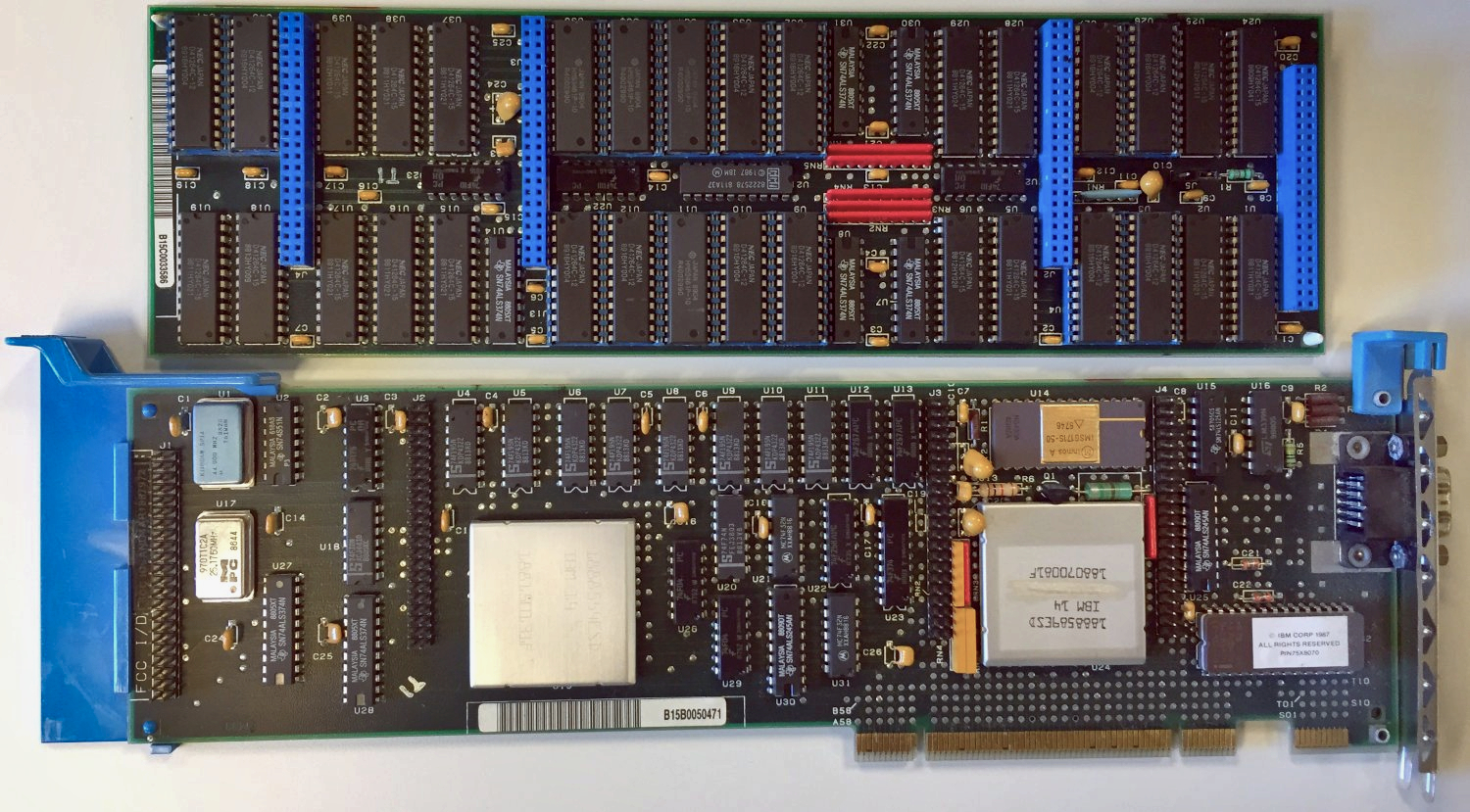|
XGA
The eXtended Graphics Array (usually called XGA) is a graphics card manufactured by IBM and introduced for the IBM PS/2 line of personal computers in 1990 as a successor to the IBM 8514, 8514/A. It supports, among other modes, a display resolution of pixels with 256 colors at 43.5 Hertz, Hz (Interlaced video, interlaced), or at 60 Hz (Progressive scan, non-interlaced) with up to 65,536 colors. The XGA-2 added an 65,536 color mode and 60 Hz non-interlaced. The XGA was introduced at $1095 with 512K VRAM and additional $350 for the 512KB memory expansion (equivalent to $ and $, respectively, in ). As with the 8514/A, XGA required a Micro Channel architecture bus at a time when Industry Standard Architecture, ISA systems were standard, however due to more extensive documentation and licensing ISA clones of XGA were made. XGA was integrated into the motherboard of the PS/2 Model 95 XP 486. An improved version called XGA-2 was introduced in 1992 at $360, worth $ ... [...More Info...] [...Related Items...] OR: [Wikipedia] [Google] [Baidu] |
|
 |
Display Resolution
The display resolution or display modes of a digital television, computer monitor, or other display device is the number of distinct pixels in each dimension that can be displayed. It can be an ambiguous term especially as the displayed resolution is controlled by different factors in cathode-ray tube (CRT) displays, flat-panel displays (including liquid-crystal displays) and projection displays using fixed picture-element (pixel) arrays. It is usually quoted as ', with the units in pixels: for example, ' means the width is 1024 pixels and the height is 768 pixels. This example would normally be spoken as "ten twenty-four by seven sixty-eight" or "ten twenty-four by seven six eight". One use of the term ''display resolution'' applies to fixed-pixel-array displays such as plasma display panels (PDP), liquid-crystal displays (LCD), Digital Light Processing (DLP) projectors, AMOLED, OLED displays, and similar technologies, and is simply the physical number of columns and rows of pi ... [...More Info...] [...Related Items...] OR: [Wikipedia] [Google] [Baidu] |
 |
IBM PS/2
The Personal System/2 or PS/2 is IBM's second generation of personal computers. Released in 1987, it officially replaced the IBM Personal Computer, IBM PC, IBM Personal Computer XT, XT, IBM Personal Computer/AT, AT, and IBM PC Convertible, PC Convertible in IBM's lineup. Many of the PS/2's innovations, such as the 16550 UART (serial port), 1440 KB 3.5-inch floppy disk format, 72-pin SIMMs, #Keyboard/mouse, PS/2 port, and #Graphics, VGA video standard, went on to become standards in the broader PC market. The PS/2 line was created by IBM partly in an attempt to recapture control of the PC market by introducing the advanced yet Vendor lock-in, proprietary Micro Channel architecture (MCA) on higher-end models. These models were in the strange position of being incompatible with the hardware standards previously established by IBM and adopted in the IBM PC compatible industry. Most major PC manufacturers balked at IBM's licensing terms for MCA-compatible hardware, particularly the pe ... [...More Info...] [...Related Items...] OR: [Wikipedia] [Google] [Baidu] |
 |
IBM Image Adapter/A
The Personal System/2 or PS/2 is IBM's second generation of personal computers. Released in 1987, it officially replaced the IBM PC, XT, AT, and PC Convertible in IBM's lineup. Many of the PS/2's innovations, such as the 16550 UART (serial port), 1440 KB 3.5-inch floppy disk format, 72-pin SIMMs, PS/2 port, and VGA video standard, went on to become standards in the broader PC market. The PS/2 line was created by IBM partly in an attempt to recapture control of the PC market by introducing the advanced yet proprietary Micro Channel architecture (MCA) on higher-end models. These models were in the strange position of being incompatible with the hardware standards previously established by IBM and adopted in the IBM PC compatible industry. Most major PC manufacturers balked at IBM's licensing terms for MCA-compatible hardware, particularly the per-machine royalties. The OS/2 operating system was announced at the same time as the PS/2 line and was intended to be the prima ... [...More Info...] [...Related Items...] OR: [Wikipedia] [Google] [Baidu] |
 |
Video Graphics Array
Video Graphics Array (VGA) is a video display controller and accompanying de facto graphics standard, first introduced with the IBM PS/2 line of computers in 1987, which became ubiquitous in the IBM PC compatible industry within three years. The term can now refer to the computer display standard, the 15-pin D-subminiature VGA connector, or the Graphics display resolution, resolution characteristic of the VGA hardware. VGA was the last IBM graphics standard to which the majority of IBM PC compatible computer manufacturers conformed, making it the Lowest common denominator#Colloquial usage, lowest common denominator that virtually all post-1990 PC graphics hardware can be expected to implement. VGA was adapted into many extended forms by third parties, collectively known as Super VGA, then gave way to custom graphics processing units which, in addition to their proprietary interfaces and capabilities, continue to implement common VGA graphics modes and interfaces to the presen ... [...More Info...] [...Related Items...] OR: [Wikipedia] [Google] [Baidu] |
 |
IBM 8514
IBM 8514 is a graphics card manufactured by IBM and introduced with the IBM PS/2 line of personal computers in 1987. It supports a display resolution of pixels with 256 colors at 43.5 Hz ( interlaced), or at 60 Hz ( non-interlaced). 8514 usually refers to the display controller hardware (such as the 8514/A display adapter). However, IBM sold the companion CRT monitor (for use with the 8514/A) which carries the same designation, 8514. The 8514 uses a standardised API called the "Adapter Interface" or AI. This interface is also used by XGA, IBM Image Adapter/A, and clones of the 8514/A and XGA such as the ATI Technologies Mach series and IIT ''AGX''. The interface allows computer software to offload common 2D-drawing operations ( line-draw, color-fill, and block copies via a blitter) onto the 8514 hardware. This frees the host CPU for other tasks, and greatly improves the speed of redrawing a graphics visual (such as a pie-chart or CAD-illustration). ... [...More Info...] [...Related Items...] OR: [Wikipedia] [Google] [Baidu] |
|
Micro Channel Architecture
Micro Channel architecture, or the Micro Channel bus, is a proprietary hardware, proprietary 16-bit computing, 16- or 32-bit computing, 32-bit parallel communication, parallel computer bus (computing), bus publicly introduced by IBM in 1987 which was used on IBM PS/2, PS/2 and other computers until the mid-1990s. Its name is commonly abbreviated as "MCA", although not by IBM. In IBM products, it superseded the Industry Standard Architecture, ISA bus and was itself subsequently superseded by the Peripheral Component Interconnect, PCI bus architecture. Background The development of Micro Channel was driven by both technical and business pressures. Technology The IBM AT bus, which later became known as the Industry Standard Architecture (ISA) bus, had a number of technical design limitations, including: * A slow bus speed. * A limited number of interrupts, fixed in hardware. * A limited number of I/O device addresses, also fixed in hardware. * Hardwired and complex configur ... [...More Info...] [...Related Items...] OR: [Wikipedia] [Google] [Baidu] |
|
 |
Graphics Card
A graphics card (also called a video card, display card, graphics accelerator, graphics adapter, VGA card/VGA, video adapter, display adapter, or colloquially GPU) is a computer expansion card that generates a feed of graphics output to a display device such as a computer monitor, monitor. Graphics cards are sometimes called ''discrete'' or ''dedicated'' graphics cards to emphasize their distinction to an graphics processing unit#Integrated graphics processing unit, integrated graphics processor on the motherboard or the central processing unit (CPU). A graphics processing unit (GPU) that performs the necessary computations is the main component in a graphics card, but the acronym "GPU" is sometimes also used to refer to the graphics card as a whole erroneously. Most graphics cards are not limited to simple display output. The graphics processing unit can be used for additional processing, which reduces the load from the CPU. Additionally, computing platforms such as OpenCL and C ... [...More Info...] [...Related Items...] OR: [Wikipedia] [Google] [Baidu] |
 |
Interlaced Video
Interlaced video (also known as interlaced scan) is a technique for doubling the perceived frame rate of a video display without consuming extra Bandwidth (signal processing), bandwidth. The interlaced signal contains two field (video), fields of a video frame captured consecutively. This enhances motion perception to the viewer, and reduces flicker (screen), flicker by taking advantage of the characteristics of the human visual system. This effectively doubles the time resolution (also called ''temporal resolution'') as compared to non-interlaced footage (for frame rates equal to field rates). Interlaced signals require a display that is natively capable of showing the individual fields in a sequential order. cathode-ray tube, CRT displays and ALiS plasma displays are made for displaying interlaced signals. Interlaced scan refers to one of two common methods for "painting" a video image on an electronic display screen (the other being progressive video, progressive scan) by sc ... [...More Info...] [...Related Items...] OR: [Wikipedia] [Google] [Baidu] |
 |
Mouse Pointer
In human–computer interaction, a cursor is an indicator used to show the current position on a computer monitor or other display device that will respond to input, such as a text cursor or a mouse pointer. Etymology ''Cursor'' is Latin for 'runner'. A cursor is a name given to the transparent slide engraved with a hairline used to mark a point on a slide rule. The term was then transferred to computers through analogy. On 14 November 1963, while attending a conference on computer graphics in Reno, Nevada, Douglas Engelbart of Augmentation Research Center (ARC) first expressed his thoughts to pursue his objective of developing both hardware and software computer technology to ''augment'' human intelligence by pondering how to adapt the underlying principles of the planimeter to inputting X- and Y-coordinate data, and envisioned something like the cursor of a mouse he initially called a ''bug'', which, in a 3-point form, could have a "drop point and 2 orthogonal wheels". He ... [...More Info...] [...Related Items...] OR: [Wikipedia] [Google] [Baidu] |
|
Hardware Register
In digital electronics, especially computing, hardware registers are circuits typically composed of flip-flops, often with many characteristics similar to memory, such as: * Using an memory or port address to select a particular register in a manner similar to a memory address. * the ability to read or write one or multiple bits at a time. Their distinguishing characteristic, however, is that they also have special hardware-related functions beyond those of ordinary memory. So, depending on the point of view, hardware registers are like memory with additional hardware-related functions; or, memory circuits are like hardware registers that just store data. Hardware registers are used in the interface between software and peripherals. Software writes them to send information to the device, and reads them to get information from the device. Some hardware devices also include registers that are not visible to software, for their internal use. Depending on their complexity, moder ... [...More Info...] [...Related Items...] OR: [Wikipedia] [Google] [Baidu] |
|
 |
Computer Multitasking
In computing, multitasking is the concurrent computing, concurrent execution of multiple tasks (also known as Process (computing), processes) over a certain period of time. New tasks can interrupt already started ones before they finish, instead of waiting for them to end. As a result, a computer executes segments of multiple tasks in an interleaved manner, while the tasks share common processing resources such as central processing units (CPUs) and main memory. Multitasking automatically interrupts the running program, saving its state (partial results, memory contents and computer register contents) and loading the saved state of another program and transferring control to it. This "context switch" may be initiated at fixed time intervals (pre-emptive multitasking), or the running program may be coded to signal to the supervisory software when it can be interrupted (cooperative multitasking). Multitasking does not require Parallel computing, parallel execution of multiple task ... [...More Info...] [...Related Items...] OR: [Wikipedia] [Google] [Baidu] |